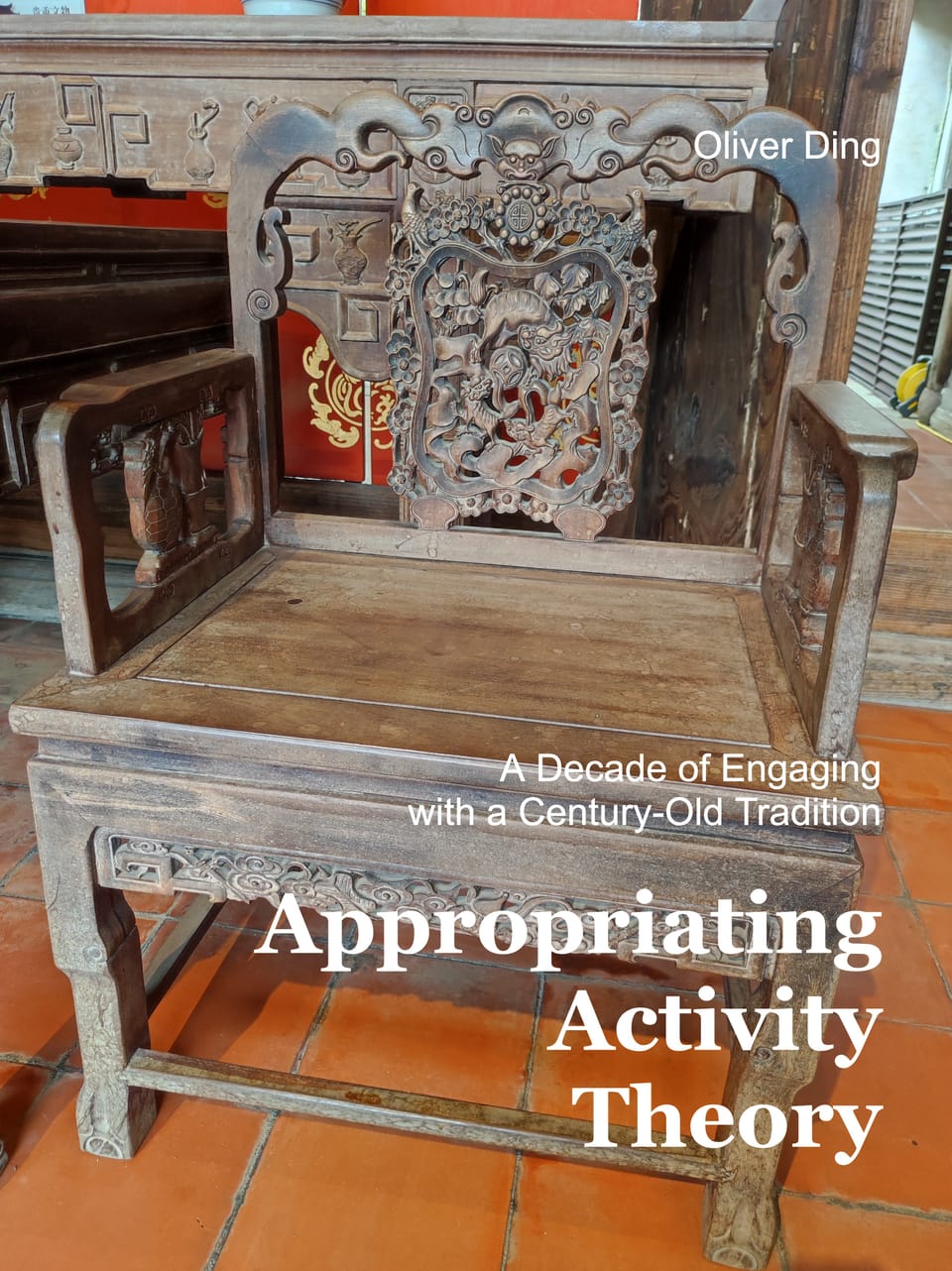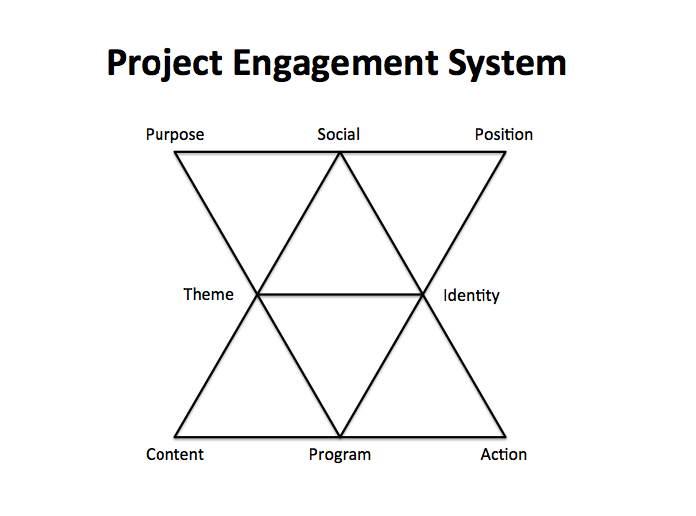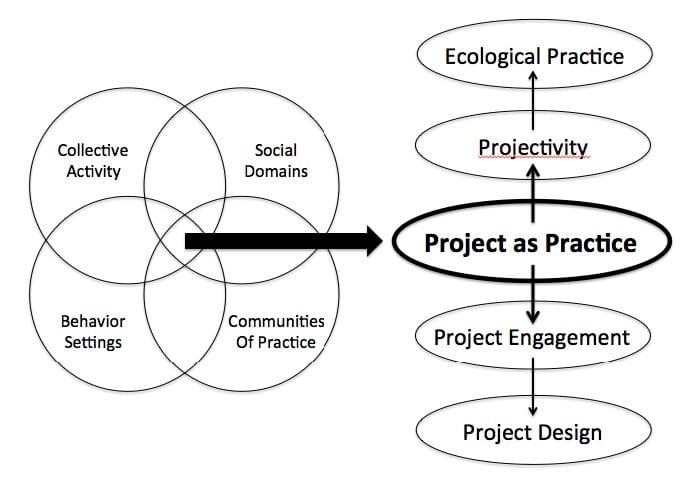Appropriating Activity Theory #2: The Project Engagement Approach in November 2020

This post is part of the "Appropriating Activity Theory" series, which reflects my creative journey of engaging with Activity Theory from 2015 to 2025.
On November 3, 2020, I sent an email to a friend to discuss my theoretical development.
The subject of the email was "Platform for Development" and "Project Engagement System."
I discussed the concept of Supportance and roughly listed four sub-categories of Supportance:
- Material Supportance (Affordance)
- Social Supportance (Attachance?)
- Cultural Supportance (Projectivity)
- Systemic Supportance (Curativity)
The term "Projectivity" refers to the Project Engagement System.
How did I develop the Project Engagement System?
1.
I used Andy Blunden's "Project as Unit of Analysis of Activity" to reflect on my experience with CIS (Corporate Identity System).
Blunden's approach highlights Hegel's theory of concepts and emphasizes three aspects of the objectification of concepts: symbolic, instrumental, and practice. This reminded me of CIS, which considers MI (Mind Identity), BI (Behavior Identity), and VI (Visual Identity).
The result was the Project Identity System. This step is what I call the "Objective-Subjective" knowledge curation.
2.
Furthermore, I connected the Project Identity System with the notion of "Themes of Practice," resulting in a paired concept: "Theme - Identity."
At this stage, I renamed the Project Engagement System.

In fact, I intended to use the Project Engagement System to support the level of Cultural Supportance (Projectivity) and the Platform for Development framework.
3.
One month later, on December 13, 2020, I wrote an article about the Platform for Developmental (P4D) Framework (v1.0). The diagram below shows the primary model of the framework.

In the original article, I cited the theoretical source of the P4D framework.
The P4D framework is a platform-based project-oriented activity-theoretical approach. The core of the framework is Platform[Project(People)] which defines a nested social structure for understanding the transformation of individuals and society.
The framework presents a systematic model of Platform[Project(People)] with three innovative concepts: “Supportance”, “Themes of Practice”, and “Identity in Practice”.
The major theoretical resources behind the framework are Activity Theory (the project-oriented approach, Andy Blunden, 2014), Social Domains Theory (Derek Layder, 1997), Ecological Psychology (James Gibson, 1979), and Self-Determination Theory (Edward Deci and Richard Ryan, 1971, 2017). I was also inspired by Knud Illeris’ How We Learn (2007) and John Hagel’s The Power of Platform (2015).
The P4D framework is expected to apply to various domains such as Startup Ecosystem, Brand and Communication, Community Engagement, Content Curation, Theoretical Traditions, Knowledge Platforms, etc.
The framework was later upgraded to v2.0, which is a set of frameworks. I renamed the original framework as the Developmental Project Model on Mar 31, 2021.
More Details
In the following sections, I will provide additional details about this brief story.
The Birth of the Project Identity System
In the email I sent to a friend on November 3, 2020, I described the process of developing the Project Identity System.
Why do I resonate with Andy Blunden’s theoretical path of “project as the unit of activity”? There are two main reasons. First, he emphasizes that a “project” can connect individuals with social life. Second, some of his ideas are closely related to the concept of Identity.
Activity Theory was originally a psychological theory at the individual level. Although it stressed the influence of social activity on the development of individual consciousness, its primary concern was still individual psychological development. When Engeström advanced Activity Theory to the level of activity systems and activity networks, applying it to organizational innovation and organizational development, the individual dimension gradually faded away. By emphasizing “project as the unit of activity,” Andy Blunden brings the individual dimension back into focus. This precisely meets my theoretical need, providing more room to explore individual development.
In this section, I highlighted my need to explore the individual development within the framework of Activity Theory.
Furthermore, the roots of Activity Theory lie in Vygotsky’s psychology, Marxism, and Hegelian philosophy. Andy Blunden traces these three intellectual traditions and extracts their discussions on projects, some of which have prompted me to reflect on the concept of Identity. For example, he points out that the concept of objectification has three dimensions: symbolic, instrumental, and practical. Objectification refers to the concretization and externalization of a project—how a project develops from a mere concept into a concrete reality. Symbolic objectification means that the project acquires a name and symbolic representations; instrumental objectification refers to how a project becomes linked with relevant objects, tools, and materials, and through activities involving them, people come together to form a community; practical objectification means that once a project develops into a community, it gradually evolves into practices within social life, becoming both a social movement and a habitual routine.
When I encountered these three dimensions, I immediately recalled the practical knowledge system of CIS (Corporate Identity System) that I focused on during the early stage of my career. CIS was developed by Motoo Nakanishi in Japan, who drew from U.S. CI practices. He expanded the American version of CI, which focused solely on visual identity, into a system emphasizing three forms of identity: MI (Mind Identity), BI (Behavior Identity), and VI (Visual Identity). Essentially, Nakanishi integrated culture, strategy, and communication into a unified whole, providing companies with a high-level framework for development. Although Nakanishi’s CIS emphasizes corporate philosophy to a great extent, it remains a practical knowledge system. Reading Andy Blunden’s work this time, I realized that the theoretical traditions of Vygotskian psychology and Hegelian philosophy could be used to re-examine the practice of CIS. The three dimensions of objectification—symbolic, instrumental, and practical—are precisely the theoretical underpinnings that correspond to Nakanishi’s three forms of identity.
In this section, I reflected on a practical knowledge system - CIS - through the lens of Hegel's theory of concepts.
Thus, by combining the theoretical path of “project as the unit of activity” with the practical knowledge system of CIS, I propose the concept of a Project Identity System. This concept has three layers of meaning. First, it shifts the focus from corporations to projects, expanding the scope of CIS and applying it to projects of all scales, thereby revitalizing the development of CIS. Second, it introduces Identity into Activity Theory, since Engeström’s activity system triangle does not include this element. Third, it links Hegel’s theory of the Concept, Vygotsky’s theory of language and sign-mediated activity, and the idea of an Identity System, thus integrating practical knowledge systems and theoretical knowledge systems into a unified whole.
In this section, I developed a new idea and gave it a new name by connecting THEORY with PRACTICE.
Renamed as Project Engagement System
As mentioned above, I expanded the Project Identity System to the Project Engagement System by connecting Theme and Identity. The details were also shared in the email.
In addition, Andy Blunden also discussed the “individual–project” relationship. He argues that an individual either develops a project or is drawn into and engaged with a project, and this process is the projecting of the self and identity. To emphasize this concept, I use the term Projectivity to describe the ecological interaction between the individual and the project, situating it within the Ecological Practice Approach.
After the concept of the Project Identity System was introduced, I continued to develop it by combining it with another concept I had previously proposed, namely Themes of Practice. Together, they form a paired concept of “Theme–Identity.” Within the Ecological Practice Approach, both of these concepts serve to link the “individual–whole” relationship, but in slightly different ways. Theme emphasizes communication and coordination—making oneself understood by others—while Identity emphasizes difference and distinction—separating oneself from others. These two concepts complement one another. For example, Global Entrepreneurship Week is a project. Its theme is “entrepreneurial community.” Other similar projects share this theme as well; hence Global Entrepreneurship Week and those similar projects share a common theme. However, in order to establish its distinctiveness, Global Entrepreneurship Week has its own logo, colors, and typography, forming a project identity system that differentiates it from other projects.
At that time, I was working on developing the Ecological Practice Approach. The Themes of Practice framework was part of Curativity Theory, a sub-theory of this approach. Curativity Theory treats the Container as an environment in which pieces are transformed into a meaningful whole. The concept of the Project was understood as a Social Container.
In addition, I have recently been reflecting on the issue of the Platform for Development, especially on how platforms empower individuals. In this process of reflection, I introduced the perspective of Activity Theory, placing the “project” as a form of activity within the background of the platform. At this point, I developed a framework model. This framework model uses the paired concept of “Theme–Identity” as its core, with six other elements as supporting components, forming an analytical model.
This analytical model is highly distinctive. When I applied it to case studies, I found that it not only offered general preliminary analytical functions but also provided some deeper analytical capabilities. At first, I continued to call it the Project Identity System. Later, I realized that Identity was only one part of the framework. Since the framework focuses on the “individual–project” relationship, I eventually renamed it the Project Engagement System.
The Platform for Development framework is an application of the Ecological Practice Approach. The concept of a Platform was understood as a Social Container. By connecting Project and Platform, I developed a nested structure. Inspired by Andy Blunden’s idea of “project as a unit of activity,” I use the term “program” to refer to informal organizing activities on platforms. This led to a new triad: People (O) — Program (A) — Platform (E).

At this stage, I realized that the framework needed a new name to encompass both the concepts of Identity and Theme. Consequently, I renamed it the Project Engagement System.
The Context of Project Engagement
Later, I tested it by comparing it with other similar knowledge frameworks, as I mentioned in the email:
After the Project Engagement System was developed, I gradually examined it in relation to other theoretical traditions. For example, the theory of Social Domains proposed by a British sociologist, the theory of Behavior Settings developed by ecological psychologist Roger Barker, and the theory of Communities of Practice advanced by Etienne Wenger. Together with the intellectual tradition of Activity Theory, these perspectives form the interdisciplinary theoretical background of the Project Engagement System. Since my emphasis is on the ecological interaction between the individual and the project, this framework should not be regarded merely as a component of Activity Theory, but rather as a component of the Ecological Practice Approach.

The diagram above provides a clear map of the landscape of Project as Practice. While the concept of Projectivity belongs to the Ecological Practice Approach, the Project Engagement System model is an independent framework.
The Platform for Development Framework (v1.0)
Later, based on the Project Engagement System model, I developed the Platform for Development Framework (v0.3). The details were shared in an article I published on December 13, 2020.
The second step is adopting Derek Layder’s Social Domains Theory as another theoretical resource.
Layder suggested four principal social domains: Psychobiography (including self-identity), Situated activity, Social setting (including fields), and Contextual resources. We have to notice these four social domains are “principal” and they can be subdivided into smaller “domains” or even understood as component elements of larger “domains”.
Thus, I applied it to expand the People (O) — Program (A) — Platform (E) framework:
- Psychobiography: Purpose (personal motivation on the development of self-identity)
- Situated activity: Program
- Contextual resources: Position
- Settings: Platform

The result is a 5P framework: People (O, organism) — Purpose (M, motivation) — Program (A, activity) — Position (R, resources) — Platform (E, Environment).
In v1.0 of the P4D framework, the concepts of Theme and Identity serve as the two core elements of the model.
At the operational level, there are many ways to apply the concept of Supportance. In order to complete the framework of “Platform for Development”, I developed a triangle to represent the three dimensions of developmental resources. The diagram below represents “Content”, “Social”, and “Action”. “Content” refers to information that is to be expressed through some medium, such as speech, writing, or any of various arts. “Social” refers to opportunities of connecting to other people. “Action” refers to operational opportunities offered by platforms. The center of the triangle is “Theme,” which refers to “Themes of Practice”.

I also found support for this schema in Knud Illeris's framework.
The three dimensions of developmental resources are inspired by Knud Illeris’ How We Learn: Learning and Non-Learning in School and Beyond (2007). Knud Illeris uses three dimensions (Content, Incentive, Interaction) to curate and sort various learning theories. I adopted the dimension of Content and separated the dimension of Interaction into Social and Action.

These three dimensions also roughly correspond to John Hagel’s typology of platforms.
- Connect users to resources — Content
- Connect individuals to communities — Social
- Move people to act together — Action
I also emphasized that these three dimensions are abstract, idealized aspects. In real life, some developmental resources encompass two or three aspects.
The triangle of developmental resources inspired me to turn the 5A framework into a new triangle. The result is the following diagram. As mentioned earlier, the 5A framework is inspired by two theoretical resources: Derek Layder’s Social Domains Theory and activity theorist Andy Blunden’s idea “project as a unit of activity”.

The center of the triangle is “Identity,” which refers to “Identity in Practice”.
...
The concept of “Identity in Practice” refers to the dialectical relation between these two types of Identity. A person is attracted by an activity (project) through its Identity, and their Identity could be shaped by the activity. On the other side, the actions of the person could also shape the Identity of the Activity.
The outcome is shown in the diagram below, which integrates the two triangles. The framework highlights eight key components and aspects of platforms, viewed as the social and cultural contexts and environments shaping individual development.

The new diagram also introduces a paired set of concepts for analysis: Theme and Identity. As mentioned above, Theme refers to Themes of Practice, while here, Identity refers to Identity in Practice. Together, these two concepts describe the meaning of “Development” from the perspective of the Platform for Development. In other words, life development involves the transformation of Themes of Practice and Identity in Practice.

I further developed five analysis modules for the P4D framework. More details can be found in The Developmental Project Model (Archived).
On March 31, 2021, I decided to rename the framework the Developmental Project Model.

Project, Platform, and Social Ecology
At the end of the email, I reviewed the significance of the Project Engagement System model and, more broadly, the Ecological Practice Approach.
Returning to the topic of platforms, the Project Engagement System framework addresses the level of Cultural Supportance (Projectivity). With this, the entire Ecological Practice Theory framework, along with its application to platform practices, becomes coherent and complete.
To summarize the theoretical contributions of the Ecological Practice Approach:
- As a framework focused on the domain of social practice, it expands the application of ecological psychology.
- Amid the growing wave of “practice research” approaches, it provides a research perspective rooted in the ideas of ecological psychology—a perspective largely absent in current practice research, which mostly draws on other theoretical traditions.
- It contributes a small but concrete, practical analytical model to the latest development of Activity Theory.
- It offers a unique theoretical perspective and a set of practical analytical tools for studying contemporary platform practices, guiding both research and practical applications.
- It provides a new lens for understanding and supporting individual development, situating personal growth within multi-level ecological structures and offering targeted concepts and models to facilitate it.
There is one particularly distinctive aspect: I focus on platforms and projects as primary research objects, which is closely related to my own personal experiences. This differs significantly from mainstream “organizational studies.” In this sense, the Ecological Practice Approach appears to be a product of the convergence of theoretical development, emerging domain trends, and individual experience.
This is the story of the Project Engagement approach during its early stage in late 2020.
On December 26, 2020, I wrote an article titled Activity U (VIII): Project as a Unit of Activity, which was part of the Activity U project.
On January 24, 2021, I edited a book draft titled Project-oriented Activity Theory, in which the Project Engagement framework was introduced in its second part.
In 2022, the concept of Platform was introduced into the Project Engagement approach (v2.1).
In 2024, the Project Engagement approach (v3.1) was released as a project-oriented social ecology.
v1: September 25, 2025 - 2,788 words
